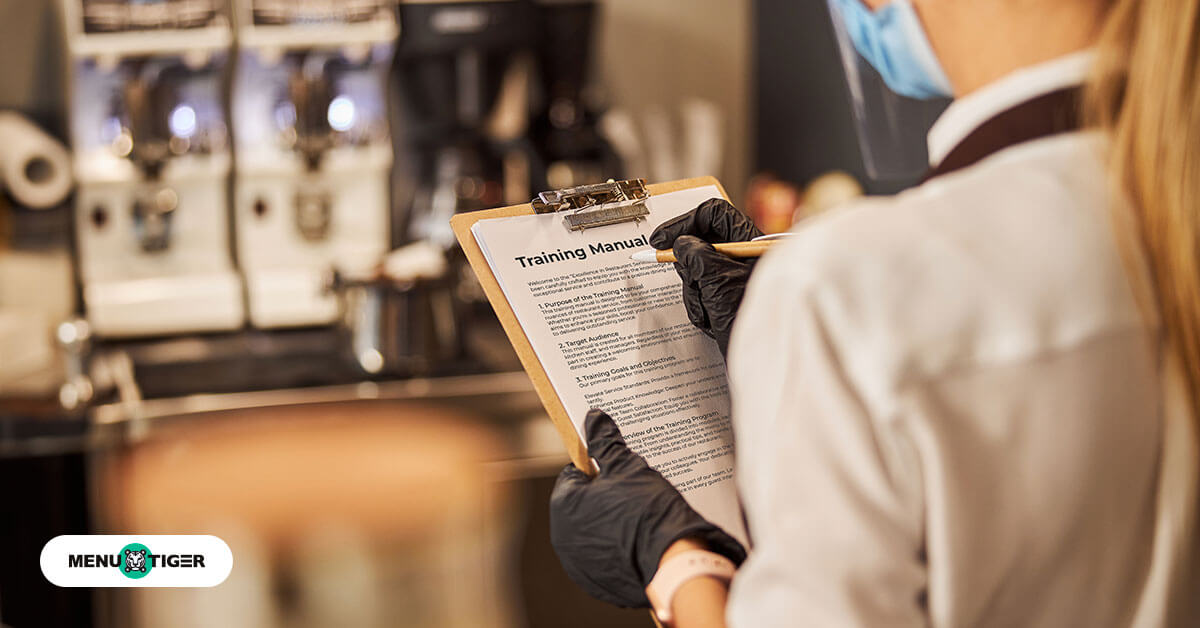
How To Create A Comprehensive Restaurant Training Manual
Last Updated: September 17, 2025
Hiring new restaurant staff is hard, but molding them into best-performing employees is even harder. This is where a restaurant training manual comes in.
A well-crafted training manual or handbook helps you introduce your business, outline accurate job expectations, provide legal policies to abide by and mitigate the risks of high employee turnover rate.
When your employees are equipped with ample knowledge about your business, they are more motivated to work and more confident to face customers and address their concerns.
This means that by merely having a training manual, you’re already securing your business with high-performing restaurant staff that help you achieve exceptional customer service.
If you don’t know how to start creating an effective employee manual, look no further because you’ve landed on the right page. Scroll down further to know more.
What is a training manual in a restaurant?
At its core, a training manual for restaurant employees is a comprehensive guide meticulously crafted to streamline the onboarding process, standardize operational procedures, and fortify the skills of every member of the restaurant.
This document serves as a repository of knowledge, embodying the establishment's collective wisdom and providing a structured framework for employee development.
Apart from extensive details about your business overview and background, it also provides information about legal procedures, health and restaurant safety guidelines, software manuals, and other job-specific training modules.
What should a training manual include?

Here are key components to include in a restaurant manager, staff, or server training manual:
Introduction and Welcome
A warm and inviting introduction sets the tone for the training manual.
It provides a brief overview of the restaurant’s mission, vision, values, history, and collective commitment to delivering an exceptional dining experience.
This section establishes your new team members' sense of belonging and purpose.
Overview of the Role
Provide a detailed overview of the employee’s role within the restaurant.
Clearly define the tasks, responsibilities, and expectations associated with the position they are filling in. This helps them get a better understanding of their contributions to your restaurant business.
Organizational Structure
A concise organizational structure chart helps employees understand the hierarchy within the restaurant.
It clearly outlines roles and reporting lines to facilitate effective communication and collaboration.
This section serves as a valuable reference, fostering a sense of order and teamwork among staff members.
Policies and Procedures
Comprehensive policies and procedures are the backbone of a successful training manual.
Covering areas such as conduct, dress code, attendance, and handling customer complaints and reservations, this section establishes the behavioral expectations for all your restaurant staff members.
By providing this framework, employees can navigate their roles confidently within the established guidelines.
For instance, if you are using a restaurant phone system to handle reservations, queries, and complaints, you can elaborately discuss the proper ways of handling these in-call transactions to foster better customer relationships.
Health and Safety
Promoting a safe and healthy work environment is paramount to achieving a sustainable and reputable restaurant.
This section outlines emergency procedures, food safety guidelines, and personal hygiene standards.
Using EMR for urgent care improves workplace safety by enabling quick access to employee health records and incident reports.
By prioritizing employees' health and safety, the manual ensures that employees are equipped to handle situations responsibly, ensuring a secure workplace.
Job-specific Training
Tailoring training to specific roles is essential for targeted skill development.
This section of your restaurant training manual provides detailed instructions for tasks related to each position, ensuring that employees gain a comprehensive understanding of their job requirements.
Implementing a kudos program can further motivate staff by acknowledging their dedication and contributions.
Role-specific training enhances efficiency and proficiency in day-to-day operations.
Customer Service Standards
Customer satisfaction is at the core of a successful restaurant. This section outlines service expectations and etiquette, empowering employees to deliver exceptional customer experiences.
By setting clear standards for customer interactions, the manual cultivates a customer-centric mindset among staff.
Menu Knowledge
In-depth knowledge of the menu is crucial for providing informed recommendations and addressing customer inquiries.
This restaurant and fast food training manual section details ingredients, allergens, and preparation methods, ensuring that staff members are well-versed in your offerings.
Menu knowledge contributes to a confident and knowledgeable front-of-house team.
Even better, your restaurant staff might even help you curate or create restaurant menu that boosts your profit.
Restaurant Software Training
The restaurant industry has gone digital. This means that operations and management are powered by technology, and familiarity with the available restaurant software is imperative.
This section guides employees through the use of point-of-sale (POS) systems, interactive restaurant menu software, online reservation tools, restaurant inventory system, and other software.
Proficiency in these technologies streamlines transactions, contributing to operations efficiency and customer service.
Sales and Marketing
This section introduces employees to promotions, specials, and upselling techniques.
By providing insights into the restaurant’s sales and marketing strategies, the training manual equips staff with the knowledge to enhance revenue and contribute to the restaurant’s overall success.
Wine and Beverage Training
For establishments serving alcoholic beverages, specialized training on wines and beverages is essential.
This section educates staff on the drink menu offerings, proper serving techniques, and responsible alcohol service.
Table Service
Effective table service is an art that contributes significantly to customer satisfaction.
This section guides your staff in setting tables, following steps of service, and maintaining a polished dining atmosphere.
Clear instructions on table service foster a professional and seamless dining experience.
Communication Skills
Effective communication is key to a cohesive team and positive customer interactions.
This section provides guidance on communication with colleagues and customers, emphasizing teamwork and professionalism.
Strong communication skills enhance efficiency and contribute to a positive work environment.
Training Schedule
A well-structured training schedule outlines the timeline for completing different modules.
This section provides a timetable for the onboarding process, ensuring that employees receive a comprehensive education without feeling overwhelmed.
A thoughtfully designed schedule contributes to a smooth transition into their roles.
Evaluation and Feedback
Establishing a process for performance evaluation and feedback is essential for continuous improvement.
This section outlines the review process, including criteria for assessment and feedback mechanisms.
Constructive feedback fosters growth, motivation, and a commitment to excellence among staff members.
Resources and References
Supplementary materials, such as forms, checklists, and additional guidelines, are housed in this section.
These resources provide ongoing support for employees, serving as quick references for various tasks.
Accessible resources contribute to efficient problem-solving and reinforce learning.
Appendix
The appendix serves as a repository for any additional materials deemed relevant. This may include detailed process maps, troubleshooting guides, or other supporting documents.
The inclusion of an appendix ensures that the manual remains comprehensive and adaptable to evolving needs.
Tips on how to improve your restaurant training manual
Here are five strategic enhancements that can help transform your training manual into a powerful tool for staff development:
Add interactive elements
Engagement is key to effective learning.
When making your restaurant server training manual, you must consider incorporating interactive elements to captivate your employees’ attention and reinforce essential concepts.
Quizzes, multimedia presentations, and scenario-based exercises can turn passive reading into an immersive learning experience.
By actively involving your staff, you enhance knowledge retention and create a more dynamic training process.
Structure the restaurant training manual into sections
Organizing your training manual into distinct sections makes it a lot easier for your employees to digest and not get overwhelmed with information.
Start with a comprehensive introduction and dedicated sections for policies, procedures, role-specific training, and more.
This structured approach, also known as microlearning, allows your employees to easily navigate the manual, focusing on the information most relevant to their roles.
A well-defined structure enhances comprehension and accessibility.
Incorporate real-life scenarios
Bring your manual to life by incorporating real-life scenarios that mirror the challenges and situations employees may encounter on the job.
By presenting practical examples, you empower your staff to apply theoretical knowledge to actual work scenarios.
In doing so, you are enhancing their problem-solving skills while consequently building confidence in handling day-to-day restaurant operations.
Introduce role-specific training paths
Recognize the different roles within your restaurant and tailor training paths to meet the specific needs of each position.
Whether it’s front-of-house, back-of-house, or managerial roles, customizing training content ensures that your employees receive targeted guidance relevant to their responsibilities.
This personalized approach easily accelerates the learning curve and fosters a sense of specialization and expertise among your team.
Provide checklists and quick reference guides
Supplement your training manual with concise checklists and reference guides that employees can easily consult during their shifts.
These tools serve as handy reminders of key procedures, steps, and protocols, promoting consistency in operations and reducing the likelihood of errors.
The importance of having a restaurant server training manual

Creating a restaurant employee training manual can bring several tangible benefits to your establishment. And it can serve as a guide to opening a restaurant, especially if you're new in the industry.
Here are some compelling reasons why you should consider investing time and resources into developing a comprehensive training manual:
Consistent operations
A training manual ensures that all employees receive consistent information about your restaurant’s policies, procedures, and standards.
This consistency helps maintain a unified positive customer experience.
Efficient onboarding process
With a well-structured training manual, the onboarding process becomes more efficient.
New hires can quickly familiarize themselves with the restaurant’s operations, reducing the time it takes them to become productive team members.
Quality control
Clearly defined standards in the manual help maintain the quality of service, food preparation, and overall operations.
This consistency contributes to a positive reputation and customer satisfaction.
Reduced employee turnover
Unclear job expectations, lack of workforce, and overwhelming working hours are three main reasons why there is a high employee turnover rate, according to a restaurant employment statistics article.
However, with a well-crafter training manual, restaurant owners and managers can avoid this from happening.
Proper training can lead to increased job satisfaction and confidence among employees.
When staff members feel well-prepared and supported, they are more likely to stay with the restaurant, reducing turnover and the associated recruitment and training costs.
Enhanced customer service
Training manuals can include guidelines on providing excellent customer service and helping your staff understand and embody the values and expectations of your restaurant.
This contributes to positive customer experiences and loyalty.
Adaptability to changes
As your restaurant evolves, the training manual can be updated to reflect changes in menus, procedures, or policies.
This adaptability ensures that all staff members are on the same page and aware of any modifications.
Legal compliance
A training manual can outline important legal and safety requirements, ensuring that your restaurant complies with regulations related to food safety, workplace safety, and employment laws.
This helps mitigate risks and potential legal issues.

Create a digestible restaurant employee training manual for efficient management and operation
Crafting a comprehensive restaurant training manual is a strategic investment in operations excellence and employee success.
From establishing a welcoming introduction to detailing role-specific training, implementing interactive elements, and ensuring consistent communication, a well-designed manual is a cornerstone for a thriving restaurant.
By recognizing and embracing these principles, you can pave the way to a knowledgeable, skilled, and cohesive team, ultimately contributing to your establishment's sustained success and reputation.
And as you go on in this restaurant journey, don’t forget that MENU TIGER has got your back. You can check out the software anytime by simply signing up for free!
Belle
Belle Boralo is a seasoned Content Writer specializing in SaaS and marketing content, known for boosting website traffic. Her background in writing essays and journalism and her love for the outdoors infuse her work with a unique and vibrant energy.


